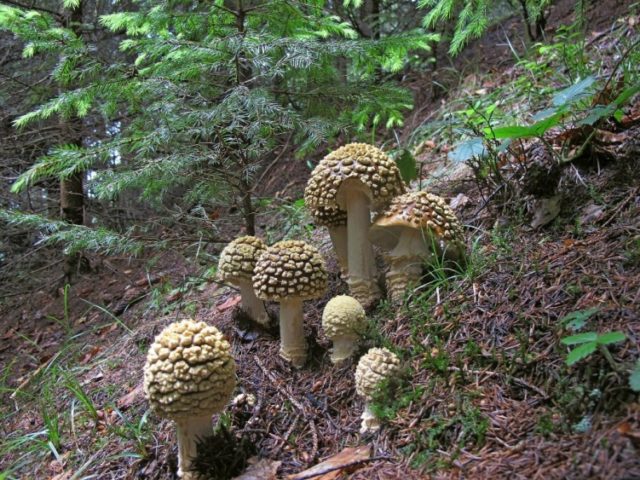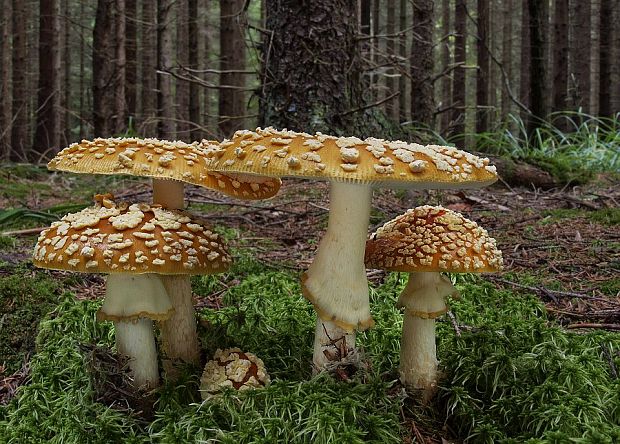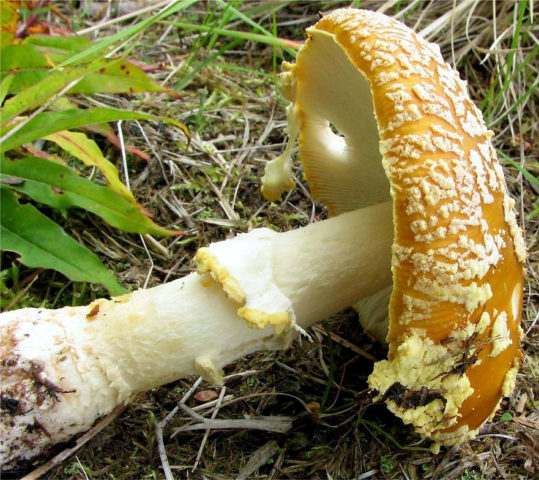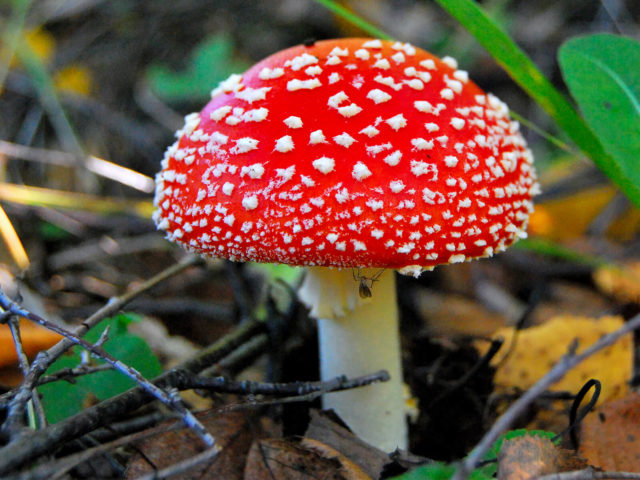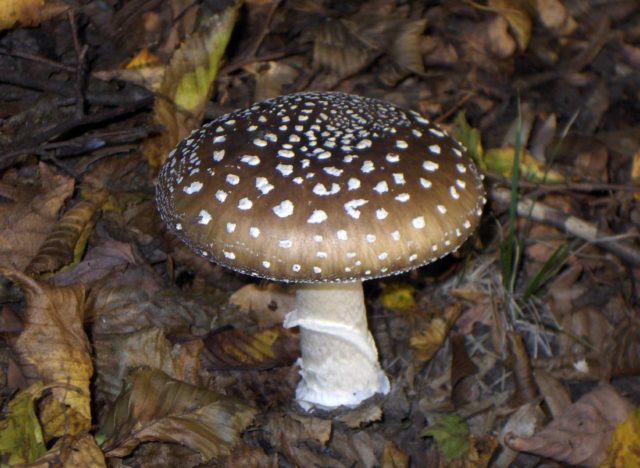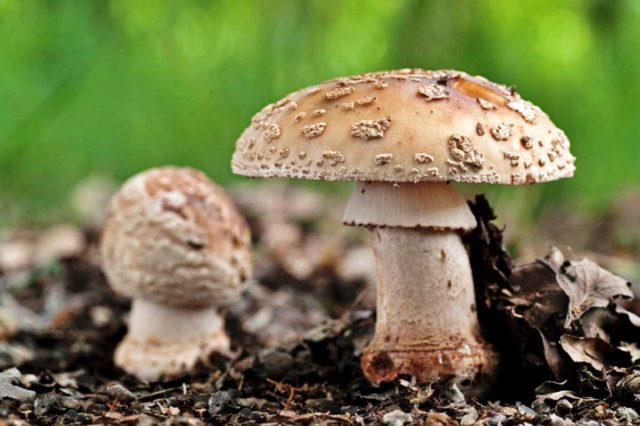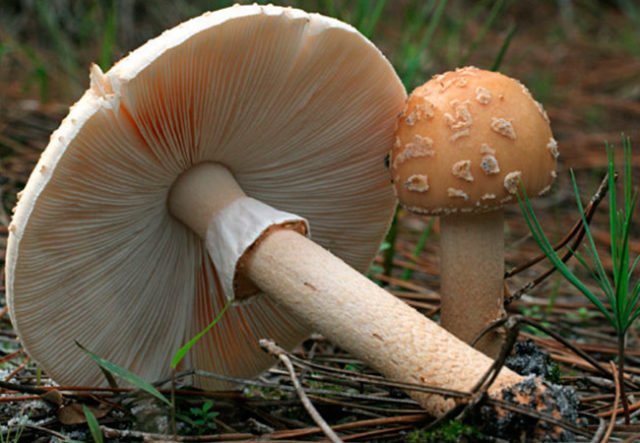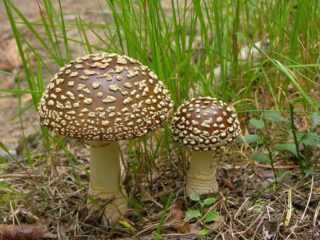Content
Amanita muscaria - hallucinogenic poisonous mushroom, common in the north and in the center of the temperate zone of the European continent. A bright representative of the Amanitaceae family in the scientific world is known as Amanita regalis. Nature lovers perceive it as an intensely colored aesthetic element of a green forest carpet.
Description of the royal fly agaric
You need to know an inedible mushroom in order not to mistakenly put it in a basket along with other gifts of the forest. The use of this species carries a mortal danger.
Description of the hat
The royal fly agaric has a large cap, from 5 to 25 cm. Features of the appearance of the cap of a young mushroom:
- spherical;
- the edges are attached to the leg;
- yellowish-white flakes are densely located on the surface of the skin.
These shapeless formations are the remnants of the veil that was wrapped around the young fruiting body of the royal mushroom. Scraps of it are easily washed off from the top of the cap, on young mushrooms they turn white in the sun, on old ones they turn gray-yellow.
As it grows, the cap opens to slightly convex or completely flat, sometimes with a slightly depressed center. It happens that the ribbed edge rises up. Amanita muscaria peel is aged in yellow-brown shades - from light on old ones to intense terracotta color on young mushrooms. The middle of a more saturated tone.
The bottom of the cap is lamellar, white. Old fly agarics have numerous wide plates - yellowish or creamy. Initially, the plates grow to the leg, then detach from it. The spore powder is white.
At the fracture of the fruiting body of the royal fly agaric, fleshy, white, pulp is visible, the smell is not expressed. If the thin skin is slightly peeled off, the flesh is golden yellow or ocher just below it. Under the influence of air, the pulp does not change its color.
Leg description
The leg is as large as the cap, height from 6 to 25 cm, thickness 1-3 cm. In young mushrooms, it is ovoid or spherical. Then it stretches, grows upward, the base remains thickened. The surface is fibrous, covered with a velvety white bloom, under which the color of the leg is yellowish or yellow-brown. In old king fly agarics, the cylindrical leg becomes hollow. Like all members of the genus, the stem has a thin white ring, often torn, with a brownish-yellow border. Volvo, part of the bedspread from below, grows to the leg. It is warty in appearance, formed by two or three rings at the base of the fruiting body.
Where and how it grows
Amanita muscaria are found in deciduous and coniferous forests, spruce and pine forests, mixed pine forests growing on mosses and in grass.Mycorrhiza is most often formed in symbiosis with the roots of birches, pines and spruces, but there are inedible mushrooms under other species. In Europe, the species is distributed mainly in the north and in the center of the continent. Likewise in Russia - the royal fly agaric is not found in the southern regions. Representatives of the species have been recorded in Alaska and Korea. Amanita muscaria appear from mid-July and grow until the first frost. Mushrooms can be seen singly and in groups. The species is considered to be quite rare.
Doubles and their differences
Going to the forest with a basket, they carefully study inedible mushrooms, including a description and a photo of the royal fly agaric.
Comment! The species is so different from edible mushrooms that it seems that its representatives cannot be confused. But mistakes often occur in inexperienced mushroom pickers who meet young or even adult specimens that have undergone such transformations as the loss of a ring or the remains of a veil.
The royal fly agaric is sometimes confused with other species of the genus Amanita:
- red;
- panther;
- gray-pink.
It is especially easy to confuse with red. From a distance, both species are similar to each other, and some microbiologists consider the royal subspecies of red. Royal fly agaric differs from red in the following ways:
- different tones of yellow-brown color of the cap do not approach an intense red tint;
- there are yellowish flakes on the leg, which red does not.
Depending on where it spawns, the royal species may come out with a pale reddish cap, making it look like the conventionally edible gray-pink that is often harvested and popular for its good taste. They are distinguished by the following parameters:
- in a pink look, the flesh turns red on the cut;
- whitish plates turn red after touching;
- the ring is pale pink.
A panther fly agaric with a brownish or gray-olive skin, especially toxic, can be a twin of the royal also due to a change in the color of the cap. But there are other differences:
- the flesh under the skin is white;
- it is brittle and watery, has an unpleasant odor similar to rare;
- the Volvo is clearly cupped;
- there is no yellow or brownish-yellow border at the bottom of the ring.
Edible royal fly agaric or poisonous
Due to the presence of a number of toxic substances, mushrooms should not be eaten in any form. Accidental ingestion of the species can be fatal.
Can the royal fly agaric cause hallucinations?
The ingress of toxic substances into the human body causes not only a general toxic effect, but also affects the nervous system, complicates the perception of the external world. Contact with the victim due to the inhibition of thought processes is almost impossible.
Poisoning symptoms, first aid
Unpleasant sensations in the gastrointestinal tract appear after 30-90 minutes or several hours. Severe colic, salivation and vomiting are accompanied by dizziness and pain in the head. Later, there is a disorder of the nervous system, hallucinations, convulsions.
First aid consists of flushing the gastrointestinal tract and transporting the victim to the hospital. The patient needs to be warmed up with a warm blanket and heating pads.
Application of the royal fly agaric
It is believed that forest dwellers eat poisonous mushrooms, getting rid of parasites. The antibacterial and antiparasitic effect of toxins is used by healers. Only specialists can apply the fly agaric treatment.
Conclusion
Amanita muscaria is rare. You can admire the poisonous mushroom and avoid it. Any self-treatment threatens with serious disruption of the body.
